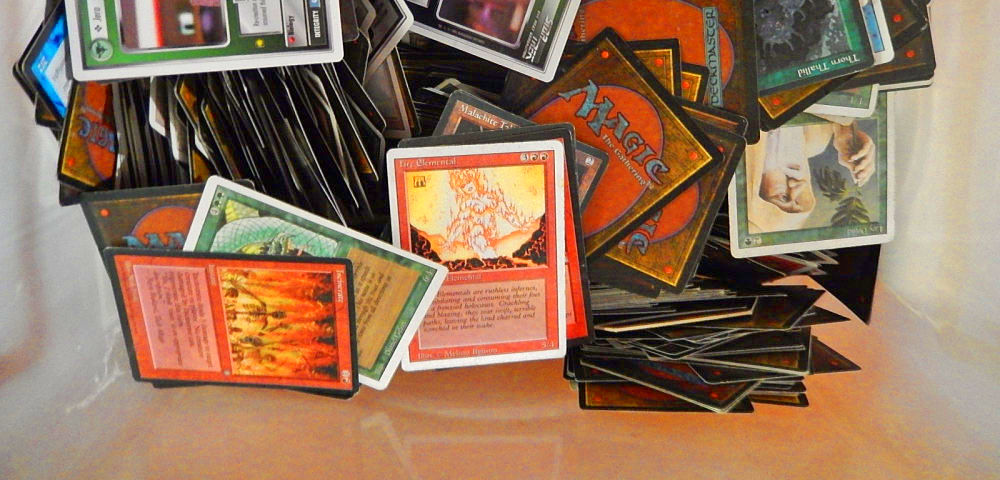Interesting Investments — Magic: The Gathering Cards

Before we begin this article in earnest, I want you to watch a video. You can skip through to about 8:12 or so, if you’d like.
All done? Then let’s discuss what just happened. In 2014, a fan of the collectible card game Magic: The Gathering taped himself opening a pack of cards from the first set available to the game, sold back in 1993. The game is still going strong today. The pack the man opened is worth anywhere from $2,000 to $5,000 due to its rarity nowadays.
The gentleman’s goal was to show what older cards look like to newer players, as the game’s art style has changed in the past 25 years. Note that he is using gloves, as many of the cards from that era are also very rare, and thus valuable to the playerbase. The second-to-last card revealed is a Tropical island, worth $3,500 even in a lightly played state. The last card revealed, the Black Lotus, is the rarest of the rare. A year prior to the video, a Black Lotus, graded at 9.5 condition by a collectible grading company, sold for more than $27,300. A Black Lotus from a later set, in heavily played condition — far less than 9.5 — can be had for a mere $3,500. A near-mint Black Lotus from the first set, Alpha, still fetches nearly $20,000. Not bad for a piece of cardboard from 1993.
You may have no interest in the game itself, but this does make an interesting investment, and is something to consider as a way of making money in an admittedly volatile market.
The Reserved List
The key to keeping card valuable is what’s called the “Reserved List.” After M:tG makers Wizards of the Coast released a card set that contained reprintings of earlier rare cards, the cards’ value tanked. Collectors were not pleased. After this, the Reserved List was created. None of the cards on the list will be functionally reprinted, preserving the power in the game the cards have, and in part the value, which also sees rarity as a factor.
Game Knowledge
Aside from rarity, part of knowing which cards will increase in value is how well they play in the game. Often, the rarer cards are more powerful in the game, and thus more desirable, pushing up prices. Knowing how the game is played helps, as does knowing what cards see more play. There are often tournaments, where professional M:tG players compete for more prize money than you would assume for what is supposed to be a children’s game.
Watching the widely available livestreams can give you insight into what makes a card good. From there, the road to profits is fairly simple: buy the card, hope that once the card is no longer widely available — card sets are only sold for a limited amount of time — the price will go up instead of down. It’s not unlike baseball cards.
Old Cards
Or, you could try to find boxes or still-sealed packs of older cards for cheap and open them, hoping to find something rare inside — as Rudy the Magic Guy does. The boxes and packs themselves, however, are also valuable, and can be sold to those also hoping to find old, rare cards. Rudy claims that there are about 1,100 copies of each of the “Rare” cards printed in Alpha, with about 500 of each still in existence.
The problem is that, with more than 16,000 cards as of December 2016 — and more sets have been released since then — it’s hard to keep track of what you open in a pack, and if it’s worth selling. It might be best to create a spreadsheet for your acquisitions. Since there are so many cards, you’ll need a system to manage what you have, especially if you open old boxes and packs instead of buying single cards. You can use Excel to color code and sort your cards, such as by rarity, giving you an overall idea of what a given box or your entire collection is worth. It’s worth noting that the same card from different sets can have different prices, especially if they have different artwork, making a spreadsheet even more of a boon. Sites like TCGPlayer will help you price out your cards.
A Word of Warning
If you haven’t already guessed, investing in Magic: The Gathering cards can be risky. It can be a volatile market, with card prices either sharply increasing or decreasing as sets rotate out. Part of this depends on whether the card was only good in “standard” play, used in tournaments, or whether it will still be good in “legacy” play, where the vast majority of the thousands of cards are all used, instead of a small subset. Plus, there’s still rarity to contend with.
If you have no knowledge of the game, find someone who plays. Ask them questions. Ask them what cards are being used right now, and when the next set is coming. Cards are “spoiled” in advance of a set becoming available, making pre-orders possible. But, some cards will remain unknown until a pro figures out a way to work them into their deck, and suddenly the price can explode. Again, it can be volatile. But, this also means there are vast profits to be found.
At the end of the day, even if you don’t make much money off the cards, if you keep some, you can at least learn to play and have even more fun.



